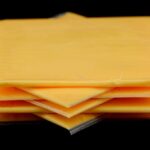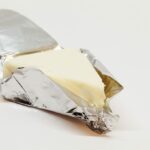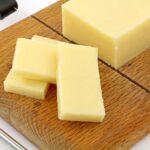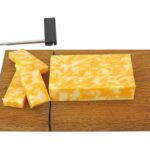Cheese is delicious and popular, playing a role in the culture and cuisine of many nations.
But the question remains: is it good for us, or a food we should limit?
In this article, we take a science-based look at the potential benefits and drawbacks of eating cheese.
Rather than just another opinion piece, let’s examine what the actual scientific research says.
Table of contents
- Cheese is a Good Source of Nutrients
- Cheese Is Relatively High In Sodium
- Cheese Is a Source of High-Quality Protein
- Cheese Has a High Saturated Fat Content
- How Does Cheese Intake Affect Cardiovascular Risk?
- Cheese, Calories, and Weight Management
- Some People Should Limit Cheese Intake
- Cheese: Is It a Healthy Choice?
Cheese is a Good Source of Nutrients

First, cheese has a reasonably good nutritional profile.
For instance, a basic Cheddar cheese provides the following nutrients per one-ounce (28.35g) serving (1):
- Calories: 114 kcal
- Protein: 6.49 g
- Calcium: 15% of the daily value (% DV)
- Selenium: 15% DV
- Vitamin A (RAE): 11% DV
- Phosphorus: 10% DV
- Riboflavin: 9% DV
- Zinc: 9% DV
While cheese isn’t the most nutrient-dense food in the world, it supplies several beneficial nutrients. The calcium content is particularly notable, and cheese is among the best dietary sources of this mineral (2).
Calcium is important for promoting healthy bones and teeth, among other roles (3).
Cheese Is Relatively High In Sodium
Another nutrient cheese contains in high amounts is sodium.
Producers use salt to make cheese because it (4, 5, 6):
- Enhances flavor
- Inhibits unwanted bacterial growth during fermentation
- Controls moisture levels
Due to this liberal salt usage, cheese is one of the most significant dietary sources of sodium (7).
According to USDA data, Cheddar cheese contains 185 mg of sodium per ounce, which is 8% of the daily value (1).
Although 8% may sound moderate, people often overconsume cheese—far exceeding a one-ounce serving—especially on foods like pizza.
The Potential Harms of Too Much Sodium
Sodium is essential, but many people consume too much.
The daily value for sodium is set at 2,300 mg by the FDA, while the American Heart Association recommends an “ideal amount” of 1,500 mg per day for most adults (8, 9).
However, 90% of American adults exceed 2,300 mg, with the average adult consuming 3,400 mg of sodium per day (10). Since sodium plays a role in blood pressure regulation, too much can elevate it, particularly when potassium intake is low (11). Elevated blood pressure is a risk factor for cardiovascular disease (CVD) and stroke (11, 12).
Recent large reviews demonstrate that:
- Reducing sodium intake lowers systolic blood pressure and reduces cardiovascular and all-cause mortality, according to a large 2024 review of 56 systematic reviews (13).
- A dose-response meta-analysis of 36 observational studies found that each 1 gram increase in daily sodium intake raises CVD risk by 6% (14).
People with high blood pressure or salt-sensitivity may want to limit cheese intake. Alternatively, low-sodium cheese options may be worth considering, with a range of products available.
Cheese Is a Source of High-Quality Protein
Cheese offers a significant amount of high-quality protein.
A typical Cheddar provides 6.5 grams of protein per ounce (28.35g) serving (1).
Many popular cheese options are also high in fat and calories. However, depending on your choice, cheese can be reasonably protein-dense—offering high protein for relatively few calories.
For example:
- Quark cheese: over 32 g of protein per 220 g cup.
- Cottage cheese: over 10 g of protein per 100 g for fewer than 100 calories.
- Fat-free cheese: 40 g of protein per 100 g, for only 164 calories.
Learn more about high-protein cheese options
Cheese Has a High Saturated Fat Content
In the United States, most public health recommendations, including the 2020–2025 Dietary Guidelines for Americans—advise restricting saturated fat to 10% of total calories (15, 16).
This is because saturated fat can raise LDL cholesterol (LDL-C), and high LDL-C increases the risk for CVD (17, 18).
Since 1 gram of saturated fat has 9 calories, 10% of a 2000-calorie diet is approximately 20 grams per day.
Dairy fat is a major source of saturated fat, so high-fat cheese products contain a lot. For instance, an ounce (28.35g) of Cheddar has 5.36 grams of saturated fat, and 100 grams has 18.9 grams (1).
However, there are some nuances to consider when evaluating the saturated fat content of cheese.
Research on How Cheese Intake Affects LDL-C Levels
Interestingly, several studies indicate cheese doesn’t raise LDL cholesterol levels as much as other high-saturated-fat foods.
Here are some examples:
- A 2025 analysis of data from two human trials—involving 197 participants—found that cheese lowered cholesterol compared to “deconstructed cheese” (dairy fat + protein + calcium supplement). In other words, fat intake was the same in both cases, but cheese still lowered cholesterol compared to the fat-matched matrix (19).
- A 2023 systematic review of 10 randomized controlled trials found that cheese has a significantly smaller impact on LDL-C than butter. Over 14 days, a mean daily cheese intake of 135 g lowered LDL-C by 0.19 mmol/L (7.3 mg/dL) compared to a fat-matched 52 g of butter (20).
- A 2015 randomized controlled trial with 153 adults demonstrated that daily intake of a Gouda-type cheese for eight weeks did not raise LDL-C compared to fat-free cheese (21).
Is it thought that cheese has this lesser effect on LDL-C due to its unique food matrix, particularly the milk fat globule membrane. Before processing, the fat in whole milk is encased in MFGM, which cheese mostly retains. MFGM is thought to slow fat absorption and lower cholesterol absorption (22, 23, 24).
In contrast, the process of making butter involves homogenizing and then churning cream, which destroys most of the MFGM (25).
But Saturated Fat From Cheese Can Still Raise LDL-C
While cheese doesn’t raise LDL-C as much as butter, it still raises it compared to some other foods.
For example, a 2015 systematic review of 12 randomized controlled trials showed that (26):
- Cheese reduced LDL-C compared to butter.
- Cheese increased LDL-C compared to tofu.
In other words, eating a large amount of cheese can raise LDL-C, depending on the comparator.
How Does Cheese Intake Affect Cardiovascular Risk?
Cheese can raise LDL cholesterol compared to some foods but not as much as other sources of saturated fat.
With this in mind, what does recent, high-quality research show?
Let’s take a look:
- A 2025 global meta-analysis found that total dairy intake was associated with a small (3.7%) reduced CVD risk. This finding was largely driven by cheese and low-fat dairy, while high-fat milk increased CVD risk (27).
- A 2023 systematic review of observational studies reported that cheese intake was associated with a 5% lower all-cause mortality risk and a 7% lower cardiovascular mortality risk (28).
- A 2017 meta-analysis of 15 observational studies found high cheese intake was associated with a 10% reduced CVD risk compared to low intake, with the greatest benefit seen at a daily dose of 40 grams (29).
As these studies show, cheese intake appears to be associated with a neutral to slightly lower cardiovascular risk in observational studies, and certainly not an increased risk.
However, this doesn’t necessarily mean that cheese is “good” for cardiovascular health. The correct interpretation is that diets containing cheese intake may reduce cardiovascular risk compared to the average diet.
Cheese, Calories, and Weight Management
Another important consideration is cheese’s calorie content.
Regular-fat cheese is high in calories and can be easy to overconsume—especially when melted into dishes or on large pizzas.
Therefore, it’s important to stick to recommended serving sizes, which is typically about one ounce (28.35g) per serving.
Research on cheese intake and body weight demonstrates mixed findings. Some observational studies show links to weight gain or weight loss, but findings from randomized controlled trials are neutral (30, 31, 32).
Some People Should Limit Cheese Intake
While cheese is a source of beneficial nutrients, some people may need to limit their intake.
These groups of people include people with:
- Milk protein allergy: Anyone with a true milk protein allergy should avoid dairy products (33, 34).
- Lactose intolerance: Lactose intolerance is estimated to impact up to 65% of the population globally (35, 36). Most people with lactose intolerance can still tolerate moderate amounts of hard cheese, but portion control is important (36).
- Salt-sensitivity or high blood pressure: Since most cheese is high in sodium, individuals with high blood pressure or salt sensitivity may need to limit cheese intake. Investigating the availability of low-sodium cheese options may also be worthwhile.
- Weight loss targets: Because cheese is high in calories and easy to overconsume, individuals attempting to lose weight will need to limit their intake through sensible portion control.
Cheese: Is It a Healthy Choice?
Cheese provides protein, an excellent source of calcium, and studies suggest it has at least a neutral impact on cardiovascular health.
However, there are some groups of people who may wish to limit cheese intake. Furthermore, while cheese offers beneficial nutrients, they are also available in other foods, so—like all foods—it’s not essential.
Cheese can be an enjoyable and reasonably nutritious addition to the diet if consumed sensibly.
The health effects largely depend on how its consumed, and in what amount. In this regard, a slice or two of hard cheese differs greatly from a family-sized pizza.
Key Points To Remember
- Cheese is an excellent source of nutrients like calcium, protein, and vitamin A—but it is also high in calories, saturated fat, and sodium.
- Randomized controlled trials suggest cheese doesn’t raise LDL-C as much as butter, despite its saturated fat content.
- Cheese can still raise LDL-C compared to some foods, like tofu.
- Observational studies indicate cheese intakeis linked to neutral or slightly reducted cardiovascular risk.
- Overconsuming cheese can lead to weight gain, making moderation key.
- Some people may need to limit cheese intake, including individuals with high blood pressure, lactose intolerance, milk protein allergy, and weight loss goals.
- Cheese can be part of a healthy diet if eaten in sensible portions.
For more on cheese, see this guide to all the different types of cheese.








